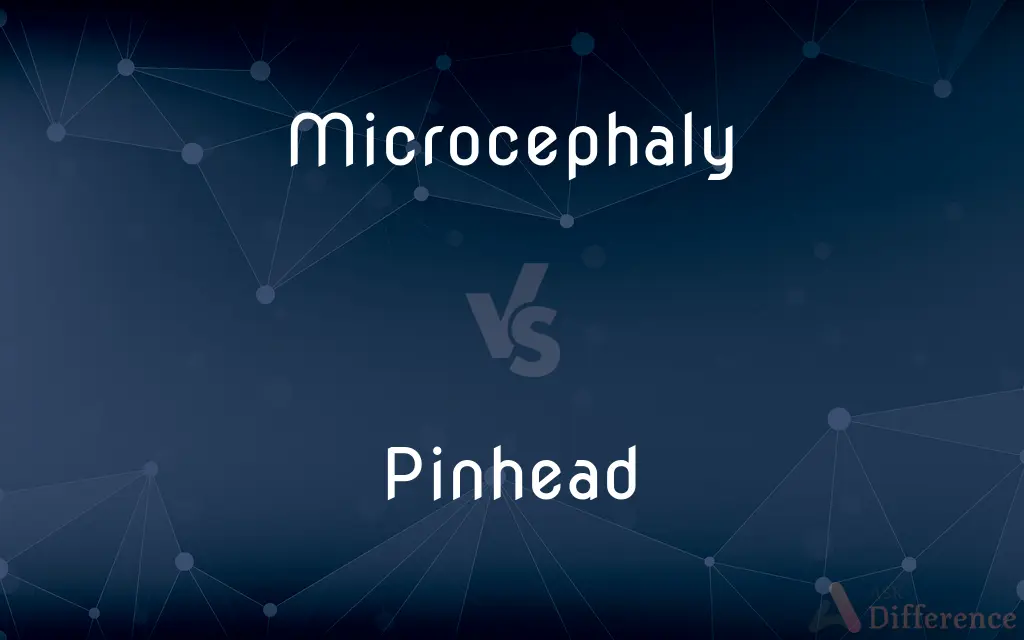Microcephaly vs. Pinhead — What's the Difference?
By Maham Liaqat & Fiza Rafique — Updated on April 22, 2024
Microcephaly is a medical condition characterized by a smaller-than-normal head size due to abnormal brain development, while "pinhead" is an outdated, derogatory term historically used to describe individuals with microcephaly.

Difference Between Microcephaly and Pinhead
Table of Contents
ADVERTISEMENT
Key Differences
Microcephaly is a serious medical diagnosis indicating a significantly smaller head circumference, which is usually the result of incomplete brain development during pregnancy or cessation of growth after birth. On the other hand, the term "pinhead" was used in the past, often in sideshows and circuses, to refer to people with microcephaly in a demeaning manner.
Individuals with microcephaly often experience developmental delays, difficulties with motor function, and other neurological complications. Whereas, the use of "pinhead" does not convey the medical complexities and tends to reduce the individual’s identity to their physical appearance.
The causes of microcephaly can include genetic factors, infections during pregnancy, such as Zika virus, or exposure to toxins. In contrast, "pinhead" does not relate to the etiology but rather was used to label affected individuals without consideration of the underlying medical reasons.
The diagnosis and management of microcephaly involve a multidisciplinary approach including pediatric neurologists, therapists, and special education professionals to support the child’s development. On the other hand, the label "pinhead" lacks any clinical or supportive implication and is viewed negatively due to its pejorative and stigmatizing connotations.
In contemporary contexts, medical professionals and advocates emphasize respectful language when referring to any individual with a disability, promoting terms that reflect medical accuracy and human dignity. Conversely, the term "pinhead" is discouraged and considered offensive, reflecting a shift towards more sensitive and respectful discourse in medicine and society.
ADVERTISEMENT
Comparison Chart
Definition
A medical condition with a smaller-than-normal head size due to underdeveloped brain.
An offensive term historically used to describe individuals with microcephaly.
Context
Medical, focused on health and developmental issues.
Derogatory, used in historical sideshows and derogatory contexts.
Implications
Associated with potential developmental challenges and neurological issues.
Carries strong negative connotations and lacks medical accuracy.
Management
Involves healthcare providers for diagnosis and treatment.
Historically not associated with supportive care or respect.
Language Sensitivity
Medically accurate and used in professional healthcare settings.
Considered derogatory and not acceptable in modern language.
Compare with Definitions
Microcephaly
Associated with genetic anomalies or environmental factors.
Certain genetic conditions linked to microcephaly can be inherited.
Pinhead
No longer acceptable in modern language.
Modern discourse promotes respectful language, avoiding terms like pinhead.
Microcephaly
A condition characterized by a smaller than normal head.
The pediatrician diagnosed the infant with microcephaly after measuring the head circumference.
Pinhead
Outdated term once used to describe individuals with microcephaly.
The term pinhead is now recognized as derogatory and is no longer used in medical contexts.
Microcephaly
Diagnosed through physical and neurological assessments.
Doctors use imaging techniques to assess brain development in microcephaly cases.
Pinhead
Often featured in exploitative settings in the past.
Individuals labeled as pinheads were often mistreated and displayed in circus sideshows.
Microcephaly
Managed through supportive therapies and interventions.
Early intervention programs for children with microcephaly focus on enhancing motor and cognitive skills.
Pinhead
Represents a shift towards more respectful terminology in society.
Society's move away from terms like pinhead mirrors greater awareness and sensitivity towards individuals with disabilities.
Microcephaly
A neurological disorder affecting brain development.
Microcephaly can lead to developmental delays and requires specialized care.
Pinhead
Reflects historical insensitivity to medical conditions.
The use of the word pinhead historically shows a lack of respect for people with disabilities.
Microcephaly
Microcephaly (from New Latin microcephalia, from Ancient Greek μικρός mikrós "small" and κεφαλή kephalé "head") is a medical condition involving a shorter-than-normal head. Microcephaly may be present at birth or it may develop in the first few years of life.
Pinhead
The head of a pin.
Microcephaly
Abnormal smallness of the head.
Pinhead
Something very small or insignificant.
Microcephaly
A neurological disorder in which the person affected has an abnormally small head due to a failure of brain growth.
Pinhead
(Slang) A stupid person; a dunce.
Microcephaly
An abnormally small head and underdeveloped brain
Pinhead
The head of a pin. Frequently used in size comparisons.
Pinhead
(slang) A foolish or stupid person.
Pinhead
(slang) A telemark skier.
Pinhead
A human head that is unusually tapered or small, often due to microcephaly, or a person with that trait. Often promoted in freak shows as "human pinheads".
Pinhead
A newborn cricket used as food for pets.
Pinhead
(mycoculture) The immature juvenile fruiting body of a mushroom prior to its gills opening.
Pinhead
An ignorant or foolish person
Pinhead
The head of a pin
Common Curiosities
How was the term "pinhead" used historically?
Historically, "pinhead" was used to describe individuals with microcephaly, particularly in exploitative entertainment settings like circuses.
Why is sensitive language important in discussing medical conditions?
Sensitive language helps maintain dignity and respect for individuals, promoting a more inclusive and compassionate society.
What kind of support do individuals with microcephaly need?
They may require various supports, including developmental therapies, educational interventions, and medical care.
Is there a cure for microcephaly?
There is no cure for microcephaly; treatment focuses on managing symptoms and supporting development.
Why is the term "pinhead" considered offensive?
The term "pinhead" is considered offensive because it derogatorily references individuals with microcephaly, reducing them to their physical appearance.
What are common causes of microcephaly?
Common causes include genetic disorders, infections during pregnancy like Zika virus, and exposure to harmful substances.
What is microcephaly?
Microcephaly is a medical condition where a baby's head is much smaller than normal, often due to abnormal brain development.
How is microcephaly diagnosed?
Microcephaly is diagnosed through measurements of head circumference, often confirmed with brain imaging to assess development.
How should one refer to individuals with microcephaly?
Refer to individuals with microcephaly respectfully, emphasizing their personal identity first, not just their medical condition.
What is the prognosis for a child with microcephaly?
The prognosis can vary widely depending on the severity of the brain development issues and associated conditions.
Share Your Discovery

Previous Comparison
Raucous vs. Ruckus
Next Comparison
Peninsula vs. DeltaAuthor Spotlight
Written by
Maham LiaqatCo-written by
Fiza RafiqueFiza Rafique is a skilled content writer at AskDifference.com, where she meticulously refines and enhances written pieces. Drawing from her vast editorial expertise, Fiza ensures clarity, accuracy, and precision in every article. Passionate about language, she continually seeks to elevate the quality of content for readers worldwide.














































